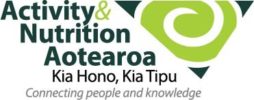13 Feb Baby food pouches friend or foe?
Squeezable food pouches containing pureed baby food have become a convenient way to feed babies and toddlers, but are they a help or a hindrance?
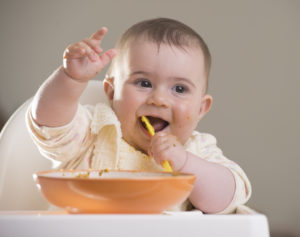
I have conducted some informal investigation and discovered pouches are a popular way to feed babies and toddlers and there’s a lot of peer pressure to use them.
This article is designed to be a conversation starter and to raise awareness of the importance of food choices in a child’s early years.
Food is a pleasure to enjoy, and how it’s presented can make a difference to the overall eating experience. I am sure you will agree that food is so much more than taste, the eye appeal is vital and of course, the aroma stimulates the appetite well before the food is presented. The anticipation and total atmosphere play an important role in food enjoyment.
Learning and development
Children need to learn to look, feel, smell and taste food and a pouch doesn’t enable all the senses to work in harmony like the food served on a plate.
Children thrive on opportunities to learn about food and the multi-sensory experiences associated with a wide variety of foods including the unique smells, the experience of chewing different consistencies and trying varying temperatures of hot and cold foods.
It takes a lot of time, practice and muscle coordination for children to learn to get food into their mouth without making a mess, so a few spills along the way are all part of the learning process. More skills are obtained from eating food from a spoon or with fingers than sucking from a tube. Playing with unfamiliar foods can help children become more open to tasting these new foods.
Feeding time can be a mission and certainly requires patience and plenty of cleaning cloths and protecting the carpet is essential! None of these things are needed with pouches making them a great choice if you want to avoid spills and chaos that are often associated with feeding babies in a highchair.
Advertising informs parents the pouches help with ‘dexterity and independence’ but there is concern among health professionals that babies who are fed mainly on pouches
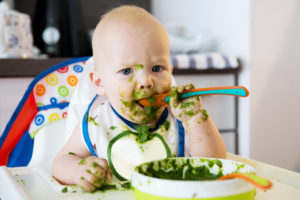
could result in missing out on important development skills that lead to healthy eating habits. This is particularly related to critical points of oral development of the tongue and muscles in the mouth, swallowing and chewing; all these factors can impact on speech development.
Texture is important
The food in a pouch must be runny enough to be squirted through a small opening so there is not much in the way of lumps or texture. Sucking foods from a pouch teaches a child to prefer velvety smooth, lump-free textures which is unlike eating food in its natural state.
Dentists are concerned about the impact of the prolonged time the food is in contact with the sweet puree that coats the teeth and gums contributing to tooth decay.
Refillable pouches that are filled with homemade puree are popular too. Getting the desired texture takes added liquid which can reduce the energy content and be inappropriate for a rapidly growing baby with high nutrition needs, especially if water is used to achieve the desired consistency.
Quantity
Children can consume large volumes of food over a short period of time from pouches. Without the chewing process eating food can be faster and less satisfying hence can result in overeating.
Babies are unique individuals and have different nutritional needs depending on age, stage, growth, development and movement yet pouches are sold as a one size fits all. A pouch labelled suitable for a 4-month-old contains the same amount of food as a pouch labelled for an 8 month old. A 120-gram pouch provides over twenty teaspoons of food and this may be either too much or too little depending on the individual.
A child may not learn about natural satiety if they continue to eat until the pouch is empty. Being able to eye the volume of food is important in learning about quantities and unless the food is served on a plate this is hard to achieve.
Convenience
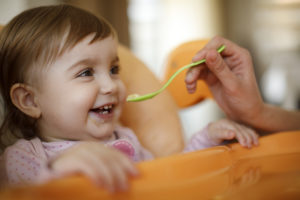
Dedicated mealtimes are an important aspect of development and I believe time should be prioritised for this social interaction. I’ve been made aware school age children enjoy smoothies made in refillable pouches which can be convenient to eat on the way to after school events preventing spills in the car while travelling. While this sounds practical, I’m not in favour of distracted eating and everyone should have time to focus on eating and enjoying food rather than gulping it down quickly in the car between activities. The rushed hustle and bustle of daily life has resulted in many families eating on the run. There is concern this type of hurried eating could result in creating long term snacking habits and the potential for overeating.
Even some early childcare centres prefer that children bring yoghurt in pouches as it produces less mess than in a pottle which can easily be knocked over and may not always be finished.
Food allergies
Research shows that a child can reduce the risk of food allergies by being exposed to certain foods between 6-12 months of age. Food in pouches is less likely to contain food that could reduce this risk such as nuts, seafood and eggs.
If relying on feeding a child food from pouches, ensure the baby is exposed to foods more likely to cause a food allergy between the critical window of 6-12 months. A couple of suggestions include adding a teaspoon of smooth peanut butter to pureed vegetables on a regular basis and an egg cooked custard.
Age appropriate
I was concerned when a new entrant teacher informed me some children come to school with pouches for lunch. This doesn’t surprise me as an advertisement popped up on my computer as I was investigating food pouches and a gorgeous school aged child feeding herself from a pouch featured in the advertisement. And another advertisement popped up later promoting pouches as ‘Great for the busy family, take with you on picnics, pack in kids’ lunches or as a convenient on the go snack’.
My biggest concern is pouches are now being used by children of all ages who are missing opportunities to learn to enjoy food. Recently at a restaurant, I shared lunch with a family with school aged children (with no special needs) who were given a pouch for lunch while the adults ordered food. That’s the scenario that drove my passion to write this article. For these children eating from a pouch was normal!
The Ministry of Health recommends a baby is breastfed (or given infant formula) until 12 months of age and food ‘solids’ are introduced around six months. Between 6-9 months milk is the main source of nutrition with food being an exciting new stage for the baby to get used to something other than sucking milk.

Food in the first few months is all about learning, experimenting and being exposed to different tastes, smells and textures which help establish lifelong eating habits. It isn’t until the child is around one year old that food becomes the main source of nutrition for the child.
It is my recommendation that from approximately one year old children should be given a wide range of food and textures as close to its natural form and I see no place for food served in a pouch after the first birthday.
As a transition from puree to family food caregivers can mix the contents of pouch food with softer family food such as pasta to create new textures.
Some yoghurts are now sold in pouches and as they aren’t in the baby food aisle, I haven’t investigated these.
Pouches are suitable as an occasional food
Apparently, pouches make up over 70% of the baby food market and they dominate the baby food aisle in supermarkets. No doubt that’s because they are easy to carry, have a shelf life of at least 12 months and don’t produce a messy feeding situation. They have their place for an occasional meal for travelling or taking to a special event where messy eating isn’t appropriate.
The pouches usually contain vegetables and almost always have added fruit to create a sweeter flavour. This makes the taste of plain vegetables or protein foods less familiar once these foods are offered later without added sweetness.
Tasting individual foods separately on a plate is an important way to develop tastes for different flavours and differentiate between foods such as sweet and sour whereas a pouch delivers one mixed flavour only per meal.
While the nutritional profile of food sold in pouches is similar to baby food sold in jars and cans, it is the delivery method of sucking from the pouch that makes these foods different from other foods on the market and the major concern for health professionals.
Safety
Ideally, the contents of the pouch should be squeezed onto a spoon or into a bowl and then spoon feed to the baby, however, in reality, this is not what is being practised in kiwi homes. One mum told me she doesn’t know anyone who does this, and all her friends let the children squeeze the contents directly into their mouths straight from the heated pouch. I explored the labels on a range of products available on the New Zealand market and feeding directly from the pouch is a recommendation on some labels.
I have concerns about food hygiene especially if the pouches are reused and saved for another meal like I’m told they are. If the pouch has been used to directly feed the baby, then the leftover should be discarded as the bacteria from the baby’s mouth and the time the food was left at room temperature is ideal for the bugs to multiply.
The pouches can be heated in the microwave and this raises further concerns with the potential to burn the babies’ mouth with food that continues to heat and the possibility of uneven temperatures with hot spots.
Some pouches come with warnings ‘explosions may occur’ and ‘ensure children are supervised as caps can be a choking hazard.’

During my discussions with caregivers about pouch use I heard some worrying stories related to safety and one dad told me when his child was ravenously hungry, the child squeezed the pouch too hard and the food came out at speed causing coughing and spluttering and the dad was concerned the child may be choking. This could have been prevented if the food was served in a bowl and eaten with a spoon.
The place of pouches for future generations
I would like to see the use of pouches minimised and children given every possible opportunity to enjoy all aspects of eating and enjoying food in its natural form.
I don’t wish to debate the contribution single use pouches may have on the environment (that’s a topic that I’m no expert in) however I acknowledge plastic food pouches are a concern in this regard.
There is a lack of studies looking into the long-term implications of baby food pouch use. The University of Otago is conducting a study to look at the evidence into the use of pouches and this evidence will be a welcome addition to the current debate.
Parents and caregivers should seek advice from a health care professional such as Well Child Tamariki Ora Nurses including Plunket, Kaiāwhina or Community Karitāne or a New Zealand Registered Dietitian if they have any concerns regarding feeding babies and young children. The Ministry of Health website contains helpful tips on feeding your baby.
Key Points
Ideally, mothers should be encouraged to breastfeed until the baby is 12 months old.
Introduce wide variety food to babies around 6 months of age.
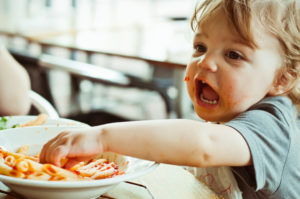
Introduce high risk allergen foods between 6-12 months.
As a baby grows, they need to learn to chew food by being given a variety of textures.
If using pouches, do so occasionally and follow the manufactures instructions and serve in a bowl with a spoon.
By one year old a child should be able to eat the same food as the family.
This article was written by Alison Pask, New Zealand Registered Dietitian
Thanks to Jennifer Douglas and Jasmine Walton ( NZ Registered Dietitians) for providing a professional review of the content of this article
February 2020
